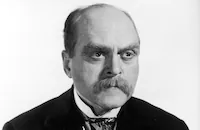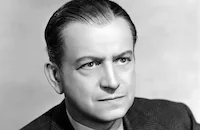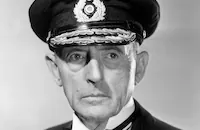The Case of the Howling Dog

Brief Synopsis
Cast & Crew
Alan Crosland
Warren William
Mary Astor
Allen Jenkins
Grant Mitchell
Helen Trenholme
Film Details
Technical Specs

Synopsis
Driven to distraction by the howling of the dog next door, Arthur Cartwright insists that lawyer Perry Mason attempt to stop it. He also wants to make a will and leave his money to the wife of Clinton Foley, the dog's owner. He explains that Evelyn, the woman now living with Foley as his wife, is not actually married to him. After he receives a copy of Cartwright's will in the mail, Perry investigates the dog problem. He sees that Foley is building an addition to his garage. While Perry talks to him, Foley receives a note announcing that Evelyn has run away with Cartwright. Perry's men investigate and learn that Evelyn was married to Cartwright and Foley took her away from him, leaving his own wife, Bessie Foley, behind. While he is watching the Foley house, one of Perry's men sees Lucy Benton, Foley's housekeeper, drive away. Later a cab arrives with Bessie Foley. She asks the driver to go next door and tell Cartwright that she is there. In the house, she and Foley quarrel and two shots are fired, killing Foley and the dog. Perry arrives after Bessie leaves and discovers the body. He tracks Bessie to her hotel. Bessie admits that Foley was consistently unfaithful, but she denies killing him. Perry advises her to say nothing to the police and does not allow her to testify at the trial that follows. During the trial, Perry demonstrates that both Cartwright and Evelyn are dead and buried under the foundation of Foley's garage. He proves that, with her left hand, Lucy wrote the letters that seemed to come from Evelyn. He claims further that the dog never would have attacked Bessie, necessitating her killing him, because the dog loved her. Perry proves that Foley killed Cartwright and Evelyn, and Bessie is acquitted. In his office, however, Perry brings in a dog that looks just like the murdered dog. When the dog delightedly greets Bessie, Perry admits that the dog that died was not Foley's dog. That dog had been put in a kennel because of his howling, which had drawn Cartwright's attention to Evelyn's murder and led to his own murder. Sure that Bessie killed Foley in self-defense, Perry cleverly did not allow her to testify and now sends her away with the dog.

Director

Alan Crosland
Cast

Warren William

Mary Astor

Allen Jenkins

Grant Mitchell
Helen Trenholme
Helen Lowell

Dorothy Tree
Gordon Westcott
Harry Tyler

Russell Hicks

Frank Reicher

Addison Richards
James Burtis
Eddie Shubert
Harry Seymour
Arthur Aylesworth
Crew

Videos
Movie Clip



Trailer
Film Details
Technical Specs

Articles
The Case of the Howling Dog
Lawyer-turned-author Erle Stanley Gardner began writing stories for pulp magazines in 1923. He created Perry Mason, his most successful fictional character, in 1933, with the novel The Case of the Velvet Claws, which also introduced secretary Della Street and investigator Paul Drake, his loyal team in what would eventually number more than 80 novels and short stories. The Case of the Howling Dog was his fourth Mason novel, serialized in Liberty Magazine in 1934 and quickly purchased by Warner Bros.
Jack Warner took a personal interest in this production, which he hoped would launch a successful new series for the studio. After considering Edward G. Robinson for the role, Warner chose William after his turn as Philo Vance in The Dragon Murder Case (1934). He assigned director Alan Crosland, an old hand and reliable craftsman with a long career handling big Warner productions in the silent era (such as Don Juan, 1926, and Old San Francisco, 1927), and famous for directing the first talkie, The Jazz Singer, in 1927. He plied Crosland with notes that bordered on micromanagement. "We want plenty of animation out of William," he wrote. "Don't let him cross his eyes through the picture. Let him do one or two twists of the mustache and three pinches of the nose and about four pulls of the ear. Also, have at least half a dozen shruggings of the shoulder and fourteen quick look-backs with the camera behind him."
This take on the famous fictional lawyer is very different from the Raymond Burr incarnation. William was the silver-haired wolf of some of the great Warner Bros. pre-Code movies, adept at playing corporate sharks with ruthless business instincts, suave manners, and an eye for younger women. His Mason is a lawyer right out of the pre-Code sensibility: cavalier with professional ethics, obstructing justice to protect a client, and flamboyant in the courtroom, where his style is filled with dramatic, showboating tactics. While he's not the lascivious wolf of previous roles, William's Mason is quite the dapper bigwig and the star attraction of a big legal firm. He's so busy he delegates most of his cases to his staff. It takes a challenge to get Mason out of his lavish skyscraper office and The Case of the Howling Dog offers just that: a nuisance complaint that careens into missing persons, false identities, murder, and a mysterious will that leaves a fortune to a mystery woman.
Mary Astor took second billing, making a memorable entrance as a mysterious woman in black. It's a small role in terms of screen time, especially for a star of her caliber, but central to the story: she immediately becomes the prime suspect and Mason's new client. She was a last minute replacement for Bette Davis, who dropped out days before production began.
Helen Trenholme plays his loyal secretary Della Street, who joins in the fun and goes undercover in a sly bit of role playing that comes back as a key point in Mason's courtroom case. In place of detective Paul Drake, Mason has a pair of staff investigators named Wheeler and Clark who tag team the stake-outs and surveillance. On the other side of the aisle, Mason races Sgt. Holcomb (wise guy character actor Allen Jenkins) to important clues and matches wits with District Attorney Claude Drumm (Grant Mitchell) in the courtroom. (D.A. Hamilton Burger and homicide detective Lt. Tragg had not yet been created by Gardner; Burger first appeared in the novels in 1935 and Tragg in 1940.)
New York Times film critic Frank S. Nugent gave The Case of the Howling Dog a glowing review. "It is a well-knit story, swiftly paced, dramatically punctuated and, above all, honest with its audience," he wrote in 1934, proclaiming "this first Gardner photoplay a welcome contribution to the entertainment of cinema mystery addicts." The film was a hit and a series was born, with William playing the role in three more Perry Mason pictures over the next two years.
Director: Alan Crosland
Screenplay: Ben Markson (screenplay); Erle Stanley Gardner (story)
Cinematography: William Rees
Art Direction: John Hughes
Film Editing: James Gibbon
Cast: Warren William (Perry Mason), Mary Astor (Bessie Foley), Allen Jenkins (Sgt. Holcomb), Grant Mitchell (District Attorney Claude Drumm), Helen Trenholme (Della Street), Helen Lowell (Elizabeth Walker), Dorothy Tree (Lucy Benton), Gordon Westcott (Arthur Cartwright), Harry Tyler (Sam Martin - Taxi Driver), Arthur Aylesworth (Sheriff Bill Pemberton).
BW-75m.
by Sean Axmaker
Sources:
"Warren William: Magnificent Scoundrel of Pre-Code Hollywood," John Stangeland. 2010, McFarland and Company.
"The Cast of the Howling Dog: A New Screen Sleuth," Frank S. Nugent. Oct 18, 1934, The New York Times.
IMDb
Wikipedia

The Case of the Howling Dog
Quotes
Trivia
Notes
Prior to its publication as a novel, Erle Stanley Gardner's story was serialized in Liberty. No background music is played in the film except for a brief time in one scene when the title song from the 1934 Warner Bros. film Dames is heard on a radio. Modern sources add the following additional cast members: Joseph Crehan (Capt. Kelly), Joseph Sawyer (Carl Trask) and Gordon Elliott (Reporter in courtroom).
This was the first film in the Perry Mason series. Warner Bros. made seven Perry Mason films between the years 1934 and 1941, when the series ended. Warren William again portrayed Mason in the next three films in the series, The Case of the Lucky Legs (1935), The Case of the Curious Bride (1935) and The Case of the Velvet Claws (1936). Ricardo Cortez took over the role of in the fifth film, The Case of the Black Cat (1936), then Donald Woods became Mason in the sixth, The Case of the Stuttering Bishop (1937). Finally, William Lundigan became Mason in the last of the series, The Case of the Black Parrott (1941). Each film in the series featured a different actress portraying Della Street. The characters were revived in a popular CBS television series that starred Raymond Burr as Perry Mason and Barbara Hale as Della Street. That series ran from 1957 to 1966. Monte Markham revived the character in a 1973-74 CBS television series that co-starred Sharon Acker as Street. Burr again starred as Mason in an irregular series of NBC made-for-television movies that began in 1985 and ended when Burr died in 1993. Hale also revived the role of Street in that series.















